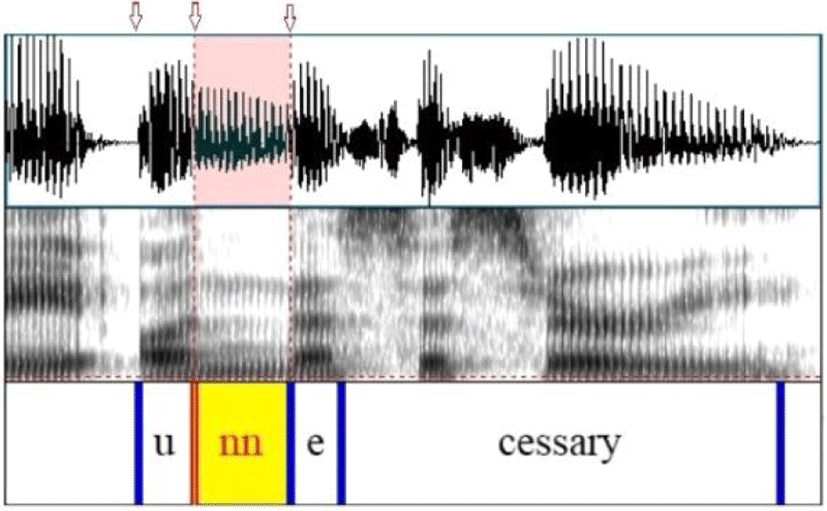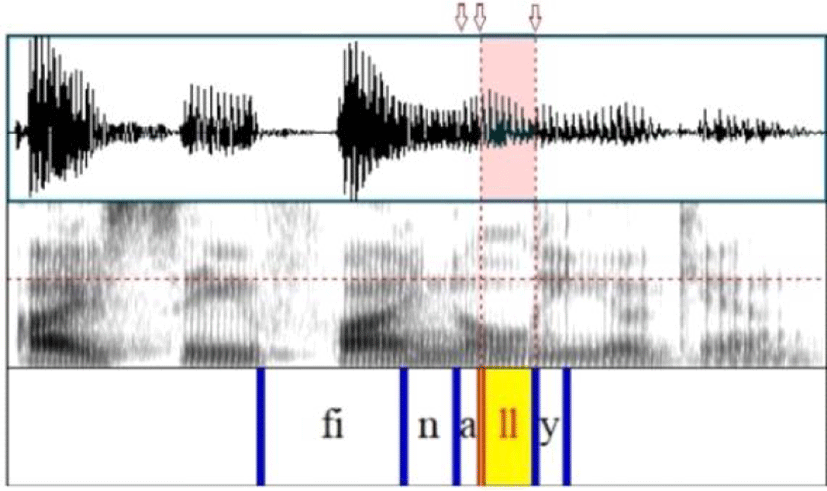1. Introduction
Geminates are regarded as two adjacent identical sounds, particularly consonants, that co-occur in a word or at a morpheme or word boundary (Trask, 1996). In many languages with phonological gemination, the primary cue for geminates is the consonant duration (Crystal, 2008; Trask, 1996). Geminate consonants are articulated with longer durations than singleton consonants in Turkish (Lahiri & Hankamer, 1988), in Italian (Esposito & Di Benedetto, 1999), and in Japanese (Idemaru & Guion, 2008). In some languages, geminate and singleton consonants are also differentiated by the preceding vowel duration. The preceding vowels of geminates are shorter than those of singletons in Italian (Esposito & Di Benedetto, 1999), and it is the opposite in Turkish (Lahiri & Hankamer, 1988).
There are three types of geminates: (1) lexical, (2) assimilated, and (3) concatenated geminates. A lexical geminate is found in a lexicon, such as pappa ‘mush’ and fatto ‘done’ in Italian. Assimilated and concatenated geminates are phonologically derived geminates (Lahiri & Hankamer, 1988; Ridouane, 2010). An assimilated geminate is found when one sound is affected by the adjacent sound, such as cheon+li →[tchʌl:i] ‘the law of nature’ (Oh & Redford, 2012). A concatenated geminate occurs when two adjacent consonants extend across the boundary of a word or morpheme, such as good dog or unknown in English. However, English lacks a true geminate-singleton contrast. Two consonants, like happy and dinner, are usually articulated as one short sound, despite being phonologically ambisyllabic in suprasegmental (Halle, 1998). Furthermore, sequences of identical consonants arise either across affixation concatenation (e.g., unknown, cleanness) or across the compound word (e.g., pine nut), but they are known as fake geminates because their lengths do not bring phonemic contrast, although they are phonetically long (Oh & Redford, 2012).
The current paper looked at English geminates arising from affixes in Korean speakers whose language has phonological geminates. This paper provides two experiments. The first experiment aimed to investigate the phonetic realization of English geminates with different affixes produced by Korean speakers. The second experiment looked at how Korean speakers articulated geminates with different degrees of decomposability.
2. Previous Studies
Few experimental studies on morphological gemination in English have been conducted (Ben Hedia, 2019), with the majority of them focusing on the prefixes in- and un-. Prefix in- has three more variants: im-, ir-, and il-. Kaye (2005) investigated gemination with un- and in- prefixes. He observed that the mean nasal durations of geminates in unknown, unnamed, and immature were longer than those of singletons in known, named, and mature. However, not all of his speakers produced long nasals for immature.
Oh & Redford (2012) looked at gemination with im- (a variant of in-) and un- (i.e., immovable and unnoticed) and across word boundaries (i.e., dim morning and one nail). The geminates were compared with lexical geminates assumed to be phonological singletons (i.e., ammonia and annex). The selected words were rated as singleton or geminate by Korean speakers based on their pronunciation by an English native speaker. First, Oh & Redford (2012) discovered that in careful speech, a pause was occasionally inserted after un- but never after im-. The authors explained that this pause gap exists because un- geminates are more represented as true geminates than im- geminates.
Furthermore, the authors observed that the durational differences between geminates and singletons were greater in careful speech than in normal speech. In careful and normal speech, the absolute nasal durations of im- and un- geminates were longer than the counterpart singletons. The geminates’ relative nasal durations (i.e., the ratio of nasal duration to the preceding vowel duration) were also longer than those of the singletons. In addition, when comparing im- and un- geminates, the absolute durations of /n/ geminate were longer than those of /m/ geminate. Oh & Redford (2012) explained that the durational difference between the /m/ and /n/ is because im- is more decomposable than un-. It is assumed that morpheme boundary strength influences the phonetic implementation of affixed words. According to Lexical Phonology theory (Kiparsky, 1982; Mohanan, 1986), the stronger the morpheme boundary (i.e., more decomposable derivatives), the less phonological integration the affixes and stems have. However, Oh & Redford (2012) observed no relative durations between the /n/ and /m/ geminates. They explained that the lack of a difference in relative durations between /m/ and /n/ geminates indicates that the preceding vowels are longer in un- than in im-. But, at word boundary, the geminates were longer than the singletons only in absolute durations, and the absolute durations of /m/ and /n/ geminates were not different.
A follow-up study by Oh (2013a) replicated some of the results of Oh & Redford (2012). In un- and im-, the absolute nasal and relative durations of the geminates were longer than those of the singletons. Oh (2013a) also measured durations of the preceding and following vowels, but found no evidence of a gemination effect on vowel durations. However, the vowel durations of un- geminates were longer than for the im- geminates. According to Oh (2013a), the vowel durations around the un- and im- geminates influence the nasal duration difference between them.
Unlike the above studies, Kotzor et al. (2016) investigated gemination with -ness and -ly, and compoundboundary geminates with sonorants [l] and [n] and stops (e.g., clown nose and bank card). The geminates were compared to singletons ending in -er, for example, coolly vs. cooler and meanness vs. meaner. The authors observed that the absolute and relative durations of geminates were longer than those of the corresponding singletons in -ness and -ly, as well as in compound words. The geminates had no effect on the preceding vowel durations. Ben Hedia (2019), however, criticized the lack of comparison of -ness and -ly geminates. She found that geminates ending with -ly were not phonetically distinct from the corresponding singletons.
3. Experiment 1
Experiment 1 explored whether Korean speakers produce durational differences between geminates and singletons in English. There are not many studies on English geminates by Korean speakers. Much of the work on English geminates has focused on word-boundary geminates and compound word geminates. Shin & Hwang (2012) used minimal pairs to investigate Korean speakers’ English geminates across word boundaries (e.g., bite toys vs. buy toys, rice seed vs. rye seed). For the geminates, their English and Korean speakers produced longer consonant durations than the singletons. In perception, however, while the English speakers always distinguished the singletons and geminates, the Korean speakers did not fully distinguish them. Both groups had similar perception accuracy for the geminates, but the English speakers had higher perception accuracy for the singletons than the Korean speakers. Shin & Hwang (2012) explained that the Korean phonological phenomena of coda neutralization and degemination brought about the poor perception of English geminates.
Oh (2020) looked at English and Korean geminates in words and across word boundaries. Korean assimilated geminates were always produced with longer durations than the corresponding singletons by the Korean speakers. Even the Koreans produced longer consonant durations for geminates represented as singletons by tensification like akki ‘instrument’, than their counterpart singletons. Except for geminate /l/, the English speakers produced mostly similar consonant durations for the Korean geminates and singletons. For English geminates, lexical geminates, geminates in compound words, and word-boundary geminates were examined. The English speakers produced significantly longer consonant durations for the geminates than for the singletons only at the word boundary. The Korean speakers tended to produce longer consonant durations for the three types of geminates than for the corresponding singletons, but significant durational differences were not found in all comparisons. According to Oh (2020), the geminate lengthening process was caused by Koreans’ tendency to be more conscious of spelling and more sensitive to syllable structure.
Korean phonology seems to affect English geminates, according to these studies on English geminates by Korean speakers. These studies, however, did not include gemination with affixes. While the words in compound words or in phrases can be replaced by other words, the affixes in affixed words are hardly alternatives to other affixes. This indicates that the affix and stem (or root) have a weaker boundary and are less likely to be apart than words in compound words (Hay, 2003). Consonant durations of geminates with affixes depend on the degree of decomposability (Oh & Redford, 2012). This study replicated previous studies on gemination in English affixation and investigated whether Korean speakers articulate geminates differently from the corresponding singletons in affixed words.
Ten native Korean speakers aged 21 to 26 took part in this experiment. They were from Seoul or Gyeonggi-do and had never lived in an English-speaking country. They all were university students. Three native English speakers from the United States also participated. To examine geminate-singleton contrast in English affixation, words with im-, un-, -ly, and -ness were selected, as shown in Table 1. Because there are so few in- prefixed words with a base beginning with /n/ (BenHedia & Plag, 2017), im- which is an allomorph of in- was chosen.
| im- | un- | ||
|---|---|---|---|
| immoral | impatient | unknown | uneasy |
| immature | impossible | unnecessary | unable |
| immodest | imperfect | unnoticed | unofficial |
| immovable | impolite | unnatural | unoccupied |
| -ness | -ly | ||
|---|---|---|---|
| humanness | emptiness | equally | happily |
| womanness | heaviness | specially | readily |
| commonness | easiness | finally | easily |
| openness | happiness | actually | heavily |
Each word was presented on the computer monitor for 5s, and the participants were asked to read the word aloud in the carrier sentence of “I say again”. The recording was made on a handy portable recorder (Zoom H2) using a Pyle-Pro PMHM2 Omnidirectional Head Worn Microphone. The recording was repeated three times in randomized order. A total of 1,248 tokens were recorded.
The primary distinctive feature between a geminate and a singleton is the consonant duration (Crystal, 2008; Trask, 1996), and geminate and singleton contrast also brings about difference in their preceding vowel durations in some language (Esposito & Di Benedetto, 1999; Lahiri & Hankamer, 1988). Absolute consonant duration and the preceding vowel duration were measured by using Praat (Boersma & Weenink, 2020) in this experiment.
Considering the participant’s different speech rates, relative duration was calculated as a ratio of absolute consonant duration to the preceding vowel duration. Figures 1 and 2 present affixed word examples by one Korean participant. Three tabs indicate the beginning of the first vowel, the offset of the vowel, which coincides with the target consonant’s onset, and the target consonant’s offset.
A nasal consonant has less energy than the surrounding vowels. Nasal and vowel boundaries are identified by a marked drop in F1 and intensity in waveform and spectrogram. There is a large region above the F1 with no energy (Ladefoged, 2006). A lateral consonant is traditionally associated with non-velarized in syllable onset, so-called light lateral, and velarized in coda position, so-called dark lateral. Light laterals typically have high F2 and low F1, while dark laterals have low F2 and high F1. The higher formants are considerably diminished in intensity (Ladefoged & Maddieson, 1996). In many studies, F2-F1 has been measured to quantify lateral quality (Sproat & Fujimura, 1993). The intervocalic laterals may be ambisyllabic or non-ambisyllabic. If the lateral is ambisyllabic, it is shared between two syllables and belongs to both a coda and an onset of the syllables. According to Lee & Seo (2019), F2-F1 of the laterals are not significantly different between ambisyllabic and non-ambisyllabic positions in English.
Cases in which the boundaries of the targeted consonants were unclear were removed from the data. Pronunciation and prosodic errors were excluded from the data. For example, the Korean group occasionally pronounced immoral and unnecessary with the primary stress on the first syllable (9 tokens) and happily as /hæpi´lI/, with the primary stress on the second syllable (4 tokens). Thus, 34 tokens were removed from the data. Furthermore, in the Korean group, elisions of the preceding vowels were occasionally found in the suffixed words. Most of the elisions occurred in openness (8 tokens), followed by easiness (4 tokens). The 20 tokens with elisions were removed from the data for the analysis of preceding vowel and relative durations.
Data analyses were performed in R by using functions of the following libraries: “ggplot2” (R Core Team, 2021; Wickham, 2016), “lme4” (Bates et al., 2015), the lmerTest R package for p-values (Kuznetsova et al., 2017), and “emmeans” (Lenth et al., 2021). Linear mixed effect models (LMER) were used with geminate (geminate and singleton) and geminate by each affix (in-, un-, -ness, and -ly) as fixed factors, and speakers and speakers by items as random factors. Absolute consonant durations (hereafter absolute durations), the preceding vowel durations, and relative durations were compared between geminates and singletons in the English and Korean groups and between the English and Korean groups. In order to see differences in the phonetic implications according to different degrees of boundary strength between im- and un-, the three durational measurements of im- and un- geminates and singletons were also compared. Because the decomposability of affixes was not rated by the participants in this experiment, statistical analysis was performed regardless of prefix and suffix, assuming that all affixes have the same morphological parsing mechanisms. If degrees of decomposability for each affix vary in data, the decomposability variable may be shown in the phonetic realization of geminates through affixes.
Table 2 presents the LMER results of absolute durations of geminates and singletons produced by the English group. The negative outcomes of Estimate (Est.) and t values indicate the absolute durations of singletons were shorter than those of the geminates.
As shown in Table 2, the absolute durations of geminates were significantly longer than those of the singletons in the un-, im-, and -ness words in the English group, but in the -ly words, the absolute durations of the geminates and singletons were not significantly different.
Table 3 shows that the geminates and singletons were not significantly distinguished by the preceding vowel durations.
Table 4 shows that the relative durations of the geminates were significantly longer than those of the singletons in the un-, im-, and -ness words. But the relative durations were not different between the geminates and singletons in the -ly words.
Despite their small number, the Korean group sometimes inserted a brief pause after un-. The brief pause was more frequently found in singleton items (14 times) than in geminate items (5 times). It has also been found once after un- in the English group. The mean absolute durations between un- geminates and singletons were not significantly different with and without a pause (t=0.91, p=.36 and t=0.32, p=.975, respectively), as they were not in Oh’s (2013a) study. Thus, un- geminates with and without a pause were not distinguished because a gap insertion had no effect on the main outcome.
Table 5 shows that the Korean group always produced significantly longer absolute durations for the geminates than for the singletons for all affixed words.
Figure 3 presents the means and standard errors of the absolute durations of geminates and singletons produced by the English and Korean groups. For each affix, from the left to the right, a white bar and a gray bar represent the absolute durations of geminates produced by English and Korean groups, and a light blue bar and a deep blue bar represent the absolute durations of singletons produced by English and Korean groups. Overall, the Korean group produced longer absolute durations than the English group, which could be attributed to the fact that the Korean groups are less fluent than the English group. A significant difference between the English and Korean groups was found in the absolute durations of the im-, un-, and -ly words (Est=26.51, SE=10.95, df=37, t=2.4, p<.05 for the im- words; Est=24.62, SE=10.9, df=36, t=2.25, p<.05 for the un- words; Est=22.26, SE=10.9, df=37, t=2.03, p<.05 for the –ly words).
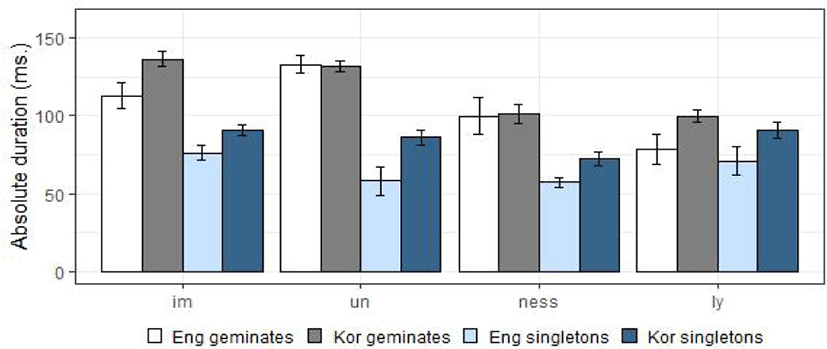
In the English group, the absolute durations of geminates in un-words were significantly longer than those in im- words (Est=20.38, SE=7.56, df=46, t=2.69, p<.001), but in the singletons between the un- and im- words, the opposite results were found (Est=–18, SE=7.55, df=45, t=–2.38, p<.05). These different patterns may be due to the effect of the following segments. Bilabial nasals are frequently longer than alveolar nasals in the word medial position, and nasals are typically longer before consonants than before vowels (Ben Hedia & Plag, 2017; Umeda, 1977). Both im- and un- geminates were followed by vowels, but the singleton im- was followed by a stop consonant while the singleton un- was followed by a vowel. However, absolute durational differences between im- and un- were not found in the Korean group’s geminates (Est=1.89, SE=4.8, df=183, t=0.9, p=.69) and singletons (Est=2.4, SE=4.82, df=181, t=0.49, p=.61).
In Table 6, in the Korean group, the preceding vowel durations of the singletons were significantly longer than for the geminates only in the -ly words. But, there was no difference between the geminates and singletons in the other affixed words.
Figure 4 shows that the preceding vowel durations in the Korean group tended to be shorter than those in the English group. The Korean group produced significantly shorter preceding vowel durations than for the English group (Est=–15.7, SE=7.17, df=25, t=–2.19, p<.05 for the im- words; Est=–16.42, SE=7.23, df=26, t= –2.27, p<.05 for the -ness words; Est=–17.97, SE=7.19). However, both group produced similar preceding vowel durations in the un- words (Est=–4.31, SE=7.16, df=25, t=–0.6, p=.55). It’s interesting to note that in the English group, the preceding vowel durations for singletons were longer than for the geminates in -ness words. It could be related to the fact that the preceding vowels of -ness geminates were all schwa [Ə], which is a reduced vowel.
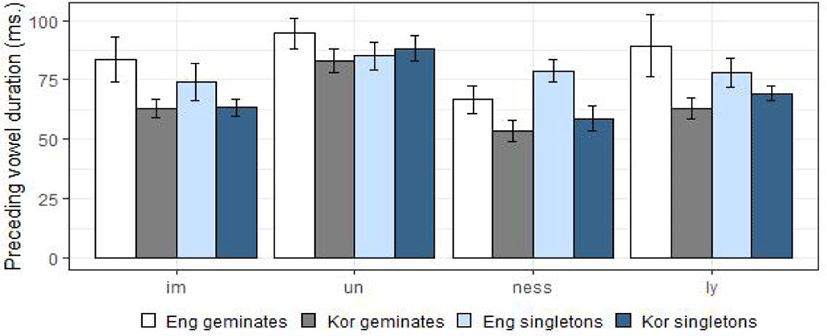
In the English group, the preceding vowel durations were significantly different between the un- and im- geminates (Est= 11.31, SE=5.27, df=46, t=2.14, p<.05) and between the un- and im- singletons (Est=11.13, SE=5.25, df=45, t=2.12, p<.05). In the Korean group, the preceding vowel durations were also significantly different between the un- and im- geminates (Est=19.74, SE=3.58, df=183, t=5.5, p<.001) and between the un- and im- singletons (Est=24.99, SE=3.59, df=180, t=6.94, p<.001).
Table 7 shows that the relative durations of the geminates were significantly longer than those of the singletons in the Korean group.
Figure 5 shows that the ranges of relative durations were greater in the Korean group than in the English group. This was to be expected given that the Korean group produced longer absolute durations but shorter preceding vowels than the English group did. The Korean group had significantly longer relative durations than the English group in the im- (Est=0.87, SE=0.29, df=54, t=2.98, p<.01) and -ness (Est=1.1, SE=0.29, df=59, t=3.68, p<.001) and -ly (Est=0.74, SE=0.29, df=57, t=2.51, p<.05) words. But in the un- words, the relative durations did not significantly differ between the two groups (Est=0.54, SE=0.29, df=55, t=1.85, p=.069).
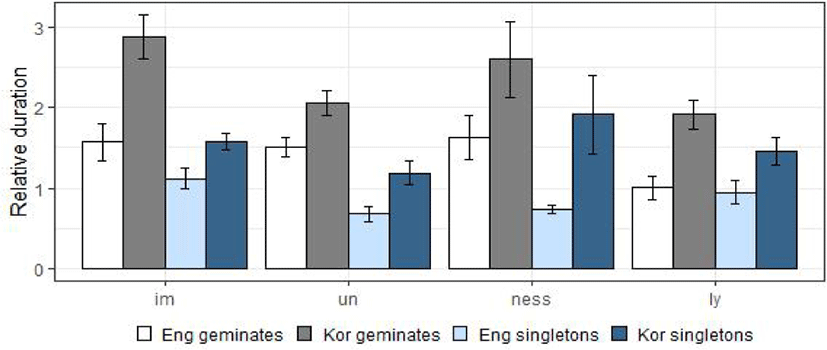
In the English group, the relative durations were significantly different only between the im- and un- singletons (Est=–0.44, SE=0.13, df=45, t=–3.31, p<.01). In the Korean group, they significantly differed between the im- and un- geminates (Est=–0.8, SE=12.69, df=183, t=–6.37, p<.001) between the im- and un- singletons (Est=–0.38, SE=0.12, df=177, t=–3.04, p<.01).
The findings of Experiment 1 support the argument that degrees of durational contrast between singletons and geminates through English affixes vary with the decomposability of affixes. However, it is more likely that the durational contrast between singletons and geminates in Korean speakers is determined by the spellings.
In the im- and un- words, the absolute and relative durations of the geminates in both English and Korean groups were longer than those of the singletons, but the preceding vowel durations did not contribute to the geminate and singleton contrast. In the English group, the absolute durations and preceding vowel durations of the un- geminates were longer than those of the im- geminates. This is consistent with the findings of Oh & Redford (2012) and Ben Hedia & Plag (2017), who claimed that un- affixed words have a stronger morphological boundary and are more decomposable than im- affixed words.
According to Lexical Phonology in Kiparsky (1982) and Mohanan (1986), affixes are devided by Level 1 and Level 2. Un- belongs to Level 2 and in- belongs to Level 1. Level 1 affixes have weak morphological boundaries and more phonological assimilation. Degemination with their stem is more expected than other affixes. But Level 2 affixes form distinct boundaries with their stem and are less phonologically integrated, so that gemination is more anticipated.
On the other hand, in comparison to English speakers, it seems that Korean speakers have a smaller gap between Level 1 and Level 2. The Korean group produced longer preceding vowels for the un- geminates than for the im- geminates but produced similar absolute durations for them. However, they sometimes inserted a brief pause after un- but never after im-. According to Oh (2013a), the brief pause indicates different morphological boundary strengths between im- and un-. Thus, it seems that the similar absolute durations of the im- and un- geminates appeared to be influenced by spellings in the Korean group, and the different decomposability between un- and im did not have a full effect on the Korean group’s English pronunciations.
Koreans usually learn English word pronunciations alongside their written forms, whereas native English speakers learn the pronunciations first. This may make Koreans more aware of how English words are spelled. Oh (2020) has proposed connecting pronunciation and spelling awareness. His Korean students clearly prefered spelling-based pronunciation of both English and Korean words. They produced longer durations than counterpart singletons in Korean, even with phonologically degeminated consonants like akki and chitssol.
Furthermore, nasals are typically longer before consonants than before vowels, and bilabial nasals are often longer than alveolar nasals in the word medial position (Umeda, 1977). As expected, the English group in this experiment produced longer absolute durations for im- singletons than for un- singletons. However, the Korean group produced a similar duration for the im- and un- singletons. This could be thought of as the effect of the spelling. Or this could be due to the influence of a morphological boundary, if not spellings. The Korean speakers in Ahn (2014) have shown no effect of a place of articulation on durations of word final nasals.
In Lexcial Phonology, both -ness and -ly belong to Level 2 (Kiparsky, 1982). However, in the English group, -ness geminated in terms of absolute and relative durations, while -ly degeminated. In the -ness words, the absolute and relative durations of the geminates were longer than those of the singletons, as in the im- and un- words. In the -ly words, the absolute and relative durations of the geminates and singletons did not differ. This absence of a durational difference supports the -ly degemination hypothesis. It is more likely that English speakers did not consider the stem and -ly to be separating. The suffix -ly is highly productive and transparent, and its decomposability is comparable to the prefix un-. Contrarily, -ly has unclear semantic meaning and is bound with a stem with weak boundary strength (Ben Hedia, 2019). According to Wells (2008), degemination occurs in -ly words because “after a stem ending in l, one l is usually lost” [as quoted in Ben Hedia (2019)], and according to Bauer (2001), there is just one /l/ when the suffix -ly is added to an adjective without final stress. In her corpus and experimental investigations on gemination in English affixation, Ben Hedia (2019) found evidence supporting the degemination of -ly, the claims of Bauer (2001) and Wells (2008). But, she also found that different factors, such as phonological environments and semantic transparency, had an impact on the degree of decomposability of -ly suffix.
In the Korean group, on the other hand, the absolute and relative durations of the geminates in the -ly words were longer than for the singletons. However, the differences in absolute and relative durations between the geminates and singletons in the -ly words were not much as those in the im-, un-, and -ness words. Actually, the mean absolute duration ratios of singleton to geminate for the -ly words did not substantially differ between the English and Korean groups. The ratio was 1:1.104 in the English group and 1:1.108 in the Korean group. Therefore, I compared the individual mean absolute durations of the geminate and singleton /l/ of the Korean group. Some of the Korean grou produced longer durations for the geminate /l/ than for the singletons /l/, while the others produced both /l/ with similar durations.
English intervocalic consonants can only be ambisyllabic if a stressed vowel comes before them (Fallow, 1976; Rudes, 1977). However, the Korean students syllabified the intervocalic lateral /l/ as ambisyllabic regardless of vowel length or stress in Oh (2013b), who studied the relationship between syllabification and phonological factors such as stress position, vowel length, and consonant type effect. Oh (2013b) explained that ambisyllabic lateral was caused by their native language. It seems that some Korean participants in this experiment may syllabify the singleton /l/ in -ly words as an ambisyllabic lateral that belongs to both coda and onset in the phonology, despite the fact that the preceding vowels were not stressed. As the Korean group articulated coda and onset /l/s in succession, the singleton /l/ in the -ly words may be lengthened as much as the geminate /l/.
On the other hand, Korean speakers who produced longer absolute and relative durations for the geminate /l/ than the singleton /l/ in this experiment may produce more -ly words depending on spelling, as they did in im-, un-, and -ness words. In general, the English proficiency of second language learners is correlated to accurate pronunciations. The various -ly patterns in absolute durations may be related to English proficiency. Unfortunately, the English proficiency of the Korean group was not examined in this experiment.
4. Experiment 2
Some studies have assumed that prefix un- geminates but prefix in- degeminates (Cohen-Goldberg, 2013; Cruttenden, 2014; Harris, 1994; Ladefoged, 2006; Mohanan, 1986). However, the findings of Experiment 1 demonstrated gemination for im- (a variant of in-), as reported by Oh & Redford (2012) and Oh (2013a). Ben Hedia & Plag (2017) noticed that prefix in- can mean either not or inner, but this distinction was not taken into account in previous studies on morphological geminates. Ben Hedia & Plag (2017) found that un- had the longest nasal duration, while locative im- (Loc im-) had a shorter nasal duration than negative im- (Neg im-). They explained that the differences in duration in Loc im-, Neg im-, and un- mirror morphological boundary strengths of the three prefixes, which are linked to semantic transparency. Both im- and un- had negative meanings in the words in Experiment 1. Despite the different degrees of decomposability, the Korean group did not distinguish between the Neg im- and un- geminates in terms of the absolute durations. Experiment 2 investigated how Loc im- and Neg im- are phonetically distinguished by Korean speakers.
Ten Korean speakers participated in Experiment 2, and six of them took part in Experiment 1. Three English speakers who participated in Experiment 1 also took part in Experiment 2. The recording and statistical analysis were carried out as in Experiment 1. The participants were shown the Loc im-, Neg im-, and un- words in Table 8 at random. Loc im- occurs more frequently on bound bases than Neg im- (Ben Hedia & Plag, 2017). In this experiment, most of the words with Loc im- have free bases. A total of 540 tokens were obtained. One token was removed due to a prosodic error. Two tokens were removed due to brief pauses after un- with excessively long nasal durations. A Korean speaker seemed to have a long nasal while thinking about the next pronunciation. Because of low frequency of words with Loc im-, “immigration” and “immigrate” which share the same root were used.
| un- | unable | unknown |
| uneven | unnoticed | |
| uneasy | unnatural | |
| Neg im- | impatient | immature |
| impossible | immutable | |
| imperfect | immodest | |
| Loc im- | impose | immersion |
| implant | immigration | |
| import | immigrate |
The absolute, preceding vowel, and relative durations of the geminates were compared to those of the singletons for each affix in each language group.
As shown in Tables 9 and 10, the LMER revealed the absolute durations of the geminates in the English group were significantly longer than for the singletons in the Neg im- and un-, but the absolute durations of the geminates and singletons in the Loc im- were not different. The absolute durations of the geminates, on the other hand, were always significantly longer than for the singletons in the Korean group.
Figure 6 shows the means and standard errors of the absolute durations of the geminates and singletons. The Korean group produced longer absolute durations than the English group. The absolute durations of Loc im-words (Est=46.85, SE=22.03, df=17, t=2.12, p<.05) and Neg im-words (Est=55.28, SE=22.03, df=17, t=2.5, p<.05) significantly differed between the two groups.
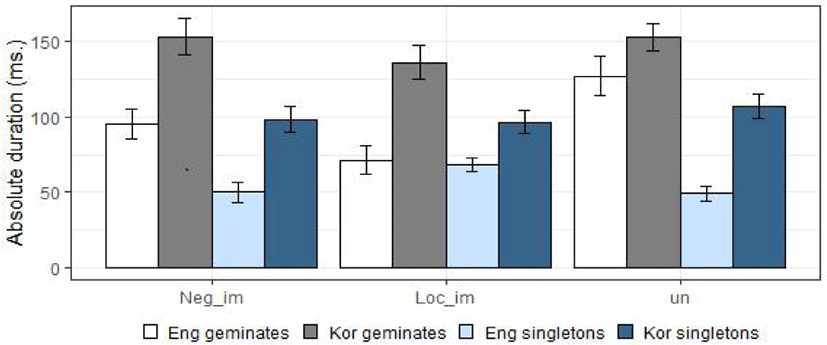
The absolute durations in the English group differed significantly between the Neg im- and Loc im- geminates (Est=31.81, SE=14.05, df=24, t=–2.26, p<.05) and between the un- and Loc im- geminates (Est=74.22, SE=14.05, df=24, t=5.28, p<.001). The absolute durations of the Neg and Loc im- singletons (Est=24.62, SE=5.49, df=26, t=4.5, p<.001), as well as the Loc im- and un- singletons (Est=25.87, SE=5.45, df=26, t=4.74, p<.001), differed significantly. In the Korean group, the absolute durations significantly differed between the Neg and Loc im- geminates (Est=21.5, SE=7.45, df=90, t=2.89, p<.01) and between the un- and Loc im- geminates (Est=18.24, SE=7.51, df=91, t=2.42, p<.05). But the absolute durations of singletons were not different at all affixes.
The preceding vowel durations of the geminates and singletons were not significantly different in the English group, as seen in Table 11. However, only in Loc im- words did the preceding vowel durations of the geminates in the Korean group differ significantly from those of singletons as shown in Table 12.
As shown in Figure 7, the Korean group produced longer preceding vowels than the English group, but a significant difference was not found between the two groups for the three prefixes.
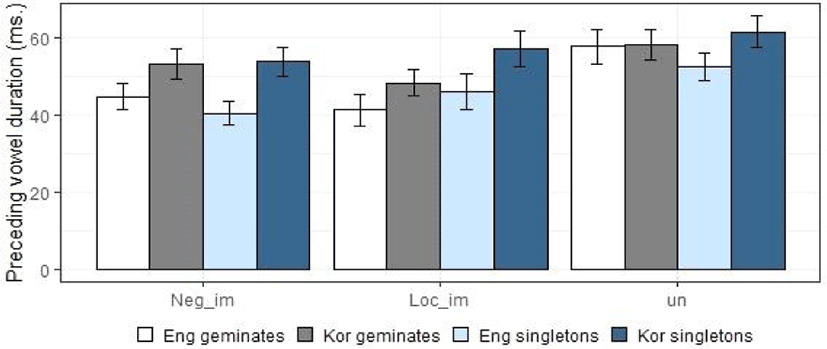
Significant differences in preceding vowel durations were found in the English group between Neg im- and un- geminates (Est=–17.14, SE=4.0, df=24, t=–4.28, p<.001) and between the Loc im- and un- geminates (Est=–21.81, SE=4.0, df=24, t=–5.44, p<.001). They were also found between the Neg im- and un- singletons (Est=–16, SE=4.49, df=25, t=–3.56, p<.01) and between the Loc im- and un- singletons (Est=–9.24, SE=4.43, df=26, t=–2.08, p<.05). In the Korean group, significant difference in preceding vowel durations were found only between the Loc im- and un- geminates (Est=–7.93, SE=3.36, df=88, t=–2.35, p<.05).
Tables 13 and 14 show the LMER results for relative durations in the English and Korean groups. While the relative durations of the geminates in the English group were significantly longer than for the singletons only in the Neg im- and un- words, the relative durations of the geminates in the Korean group were always significantly longer than for the singletons.
Figure 8 shows that the Korean group had greater ranges of relative durations than the English group, but a significant difference was not found between the two groups. The relative durations in the English group were significantly different only in the singletons between Neg im- and Loc im- (Est=0.34, SE=0.15, df=25, t=2.24, p<.05) and between Loc im- and un- (Est=0.35, SE=0.15, df=25, t=4.24, p<.001). In the Korean group, any significant difference was not found.
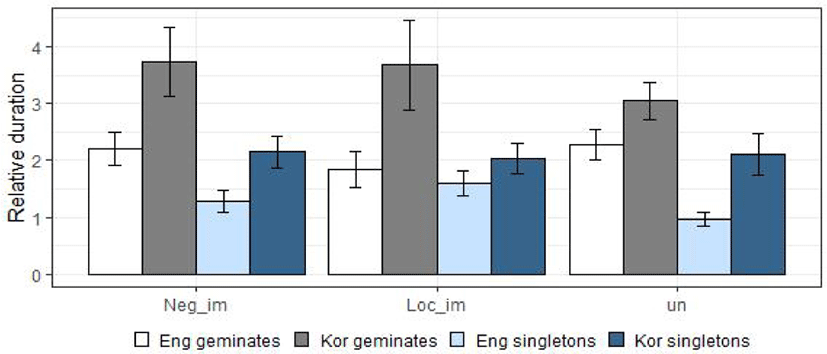
Experiment 2 confirmed the findings in Experiment 1 for geminate-singleton contrast in un- and Neg im- words. The un- and Neg im- geminates had significantly longer absolute and relative durations than the counterpart singletons in both English and Korean groups. However, when it came to the Loc im- words, the English and Korean groups exhibited different results.
In the English group, in Loc im- words, the absolute and relative durations of geminates and singletons did not significantly differ. This means that unlike un- and Neg im-, the double spelled <mm> in Loc im- words were not geminated. In this experiment, because Loc im- degeminate in the English speakers, hereafter, double <mm> and single <m> will be used instead of geminates and singletons for Loc im-. Furthermore, the mean absolute durations of double <mm> of Loc im- were the shortest, followed by Neg im- geminates and un- geminates in the English group. This may imply that the boundary strengths of three prefixes with stem vary and that Loc im- is a less decomposable prefix and un- is a more decomposable prefix based on Lexical Phonology theory, which proposes that affixes have different degrees of morphological boundary strength (Kiparsky, 1982; Mohanan, 1986). That is, the Loc im- words were more likely to be regarded as whole words by the English speakers.
Furthermore, as shown in Figure 7, the mean absolute duration of single <m> of Loc im- was longer than that of Neg im- singletons in the English group. Some studies have shown that non-morphemic /s/ and /z/ in English have longer fricative durations than /s/ and /z/ in the plural and verb past (Plag et al., 2017; Tomaschek et al., 2019; Zimmermann, 2016). The non-morphemic /s/ and /z/ are unquestionably less decomposable than the plural and verb past /s/ and /z/. Therefore, given that the mean absolute duration of single <m> in Loc im- was longer than that of Neg im- singletons, it may be reasonable to conclude that Loc im- is less separable from stems compared to Neg im-.
In the Korean group, the mean absolute and relative durations of double <mm> were longer than for single <m> in the Loc im- words. This may suggest that the orthographic effect resulted in the durational contrast between double and single nasal consonants through Loc im-, Neg im-, and un- in the Korean group. Nevertheless, the durational differences between the double <mm> and single <m> in Loc im- words were not as much as those in Neg im and un- words in the Korean group, as shown in Figure 7. This could explain the different degrees of decomposability of Neg and Loc im-. However, it cannot be ignored that the low frequency of words starting Loc im- could affect absolute durations of Loc im- words in the Korean group.
In addition, unlike Neg im- and un- words, the preceding vowel durations of the double <mm> in the Loc im- words were significantly shorter than for the single <m> in the Korean group. The preceding vowel durations of the double <ll> in the ly words in Experiment 1 were also significantly shorter than for the single <l>. The levels of decomposability of Loc im- and -ly affixes have been similarly lower in Ben Hedia (2019). Thus, further study is needed to determine whether there is a link between lower decomposability of affixes and preceding vowel durations in Korean speakers.
5. Summary and Conclusion
This paper investigated gemination with five different types of affixes, Neg im-, Loc im-, un-, -ness, and -ly. In the English group, Neg im-, un-, and -ness affixes geminated in terms of their absolute and relative durations, but Loc im- and -ly affixes degeminated. These findings may support the assumption that gemination in affixation is dependent on the degrees of morphological decomposability of the affix and root (Hay, 2003). However, in the Korean group, all Neg im-, Loc im-, un-, -ness, and -ly, affixes geminated in terms of absolute and relative durations. This may be evidence of the effects of orthographic representation on Korean speakers’ English pronunciations. Compared to Neg im-, un-, and -ness words, on the other hand, the relatively small duration differences between double and single consonants in Loc im- and -ly words, may demonstrate that the degrees of morphological decomposability of the affixed words were not totally disregarded by the Korean speakers. But, this paper has drawbacks. As one reviewer pointed out, the syllable numbers and phonological environments such as types of surrounding vowels and stress are not the same for the geminates and singletons in the words. Since these variables cannot be said to be independent of consonant length, geminates and singleton consonants in affixed words should be examined within a more controlled phonological environment in further studies.








